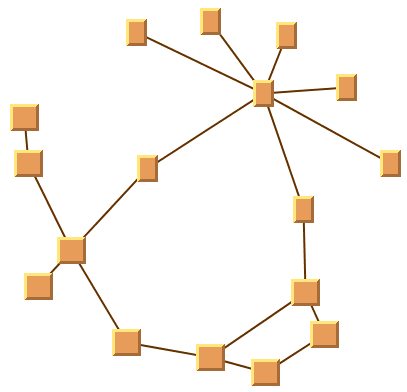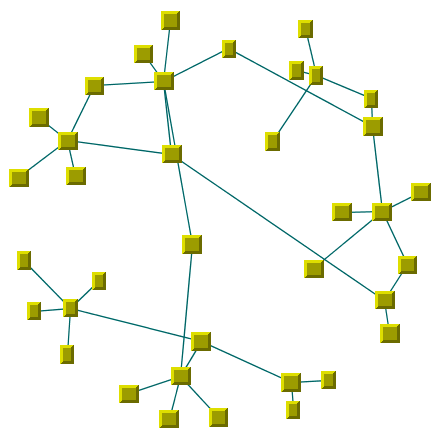- java.lang.Object
-
- ilog.views.graphlayout.IlvGraphLayout
-
- ilog.views.graphlayout.springembedder.IlvSpringEmbedderLayout
-
Deprecated.Beginning with JViews 8.5, use the classIlvUniformLengthEdgesLayoutinstead.
public class IlvSpringEmbedderLayout extends IlvGraphLayout
The main class for the Spring Embedder Layout algorithm.The Spring Embedder Layout algorithm can be used to lay out any type of graph. It often provides a drawing with no edge crossings or few edge crossings for small- and medium-sized graphs. The nodes are placed inside a rectangle which is controlled by the
layoutRegionparameter. It is important to specify a layout region that is in proportion to the number and size of the nodes.This algorithm is based on an analogy between graph drawings and mechanical systems: Nodes correspond to point masses and edges correspond to springs. Attractive and repulsive forces between each pair of nodes are defined depending on the distance between the nodes and the connectivity of the graph. The algorithm searches a sort of minimal-energy configuration of the graph, computing iteratively the positions of the nodes.
Sample drawings produced with the Spring Embedder algorithm:


See the corresponding chapter of the User's Manual for details on the algorithm, the types of graphs for which this algorithm can be used, the features and limitations, code samples, parameters, and so on.
Note that the initial position of the nodes (at the moment you start the layout) does not affect the resulting layout However, nodes specified as fixed are not moved if you call the method
setPreserveFixedNodeswith atrueargument.
CSS example:
SDM {
GraphLayout : true;
}
GraphLayout {
graphLayout : @#layout;
// optional settings for the graph layout renderer
}
Subobject#layout {
class : "ilog.views.graphlayout.springembedder.IlvSpringEmbedderLayout";
allowedTime : "3";
animate : "false";
coordinatesMode : "MANAGER_COORDINATES";
layoutOfConnectedComponentsEnabled : "false";
linkStyle : "STRAIGHT_LINE_STYLE";
memorySavings : "false";
minBusyTime : "3";
seedValueForRandomGenerator : "3";
springConstant : "3.0";
useSeedValueForRandomGenerator : "false";
}
CSS specification of per-node and per-link layout parameters:The following table lists the per-object rendering properties of the
GraphLayoutrenderer:PropertyTypeDefaultDescriptionGraphLayoutIlvGraphLayoutnullLets you define a different graph layout algorithm for each subgraph. If one is not specified, the same algorithm is applied recursively to all subgraphs.LayoutFixedStringfalseDeprecated, replaced by Fixed.FixedStringfalseLets you specify that the node or link must not be moved or reshaped by the layout algorithm.LayoutGroupStringnullLets you apply the algorithm to different groups of objects, one group after the other.LayoutIgnoredbooleanfalseIftrue, the object is ignored by the layout.The per-node and per-link layout parameters are specified in the style sheet through the CSS rules for nodes and links, not through the CSS rule for graph layout. For instance:
link.tag {
LinkStyle : "ORTHOGONAL_STYLE";
}
Note that the names of the node and link layout parameters use an initial capital, unlike the regular properties. See also the documentation of the class IlvGraphLayoutRenderer.
- See Also:
IlvUniformLengthEdgesLayout
-
-
Property Summary
Properties Modifier and Type Property and Description longallowedTimeDeprecated.
Sets the upper limit for the duration of the layout algorithm.booleananimateDeprecated.
If the argument istrue, specifies that layout algorithms that support the animation mechanism will require the graph model to redraw the graph after each iteration or step.java.lang.StringclassDeprecated.
Default constructor.intcoordinatesModeDeprecated.
Sets the coordinates mode to be used during layout.booleanlayoutOfConnectedComponentsEnabledDeprecated.
Sets whether the generic connected component layout mechanism is enabled.intlinkStyleDeprecated.
Sets the style of the shape of the links.booleanmemorySavingsDeprecated.
Sets whether the layout algorithm uses the memory saving mode.longminBusyTimeDeprecated.
Sets the minimal time that the layout algorithm can be busy.longseedValueForRandomGeneratorDeprecated.
Sets the seed value for the random generator.doublespringConstantDeprecated.
Sets the constant for the springs.booleanuseSeedValueForRandomGeneratorDeprecated.
Sets whether the user-defined seed value should be used for the random generator.
-
-
-
Property Detail
-
class
public java.lang.String class
Deprecated.
Default constructor.
CSS example:class : "ilog.views.graphlayout.springembedder.IlvSpringEmbedderLayout";
-
allowedTime
public long allowedTime
Deprecated.
Sets the upper limit for the duration of the layout algorithm.When an iterative layout algorithm is used, the iterations can be stopped when this time is exceeded. Noniterative algorithms can also use this parameter as an upper limit for the computation time. The default value is normally
32000(32 seconds). Subclasses that support this feature can use a different default value depending on their particular behavior. Layout algorithms that are stopped in this way set the result code of the layout report either toIlvGraphLayoutReport#STOPPED_AND_VALIDor toIlvGraphLayoutReport#STOPPED_AND_INVALID.When the connected components of disconnected graphs are laid out separately (see
#supportsLayoutOfConnectedComponents()), the specified allowed time is considered as the total time for the layout of all the connected components plus the time for the connected components layout.Note that the layout algorithm may not obey exactly the allowed time specification.
Note for implementers of layout algorithms: the method
#performLayout(boolean, boolean, boolean)does NOT automatically stop the layout when the allowed time is exceeded. It is the sole responsibility of the implementation of the method#layout(boolean)to do this.A
RuntimeExceptionis thrown if the layout does not support this mechanism.
CSS example:allowedTime : "3";
-
animate
public boolean animate
Deprecated.
If the argument istrue, specifies that layout algorithms that support the animation mechanism will require the graph model to redraw the graph after each iteration or step.The default value is
false.A
RuntimeExceptionis thrown if the layout does not support this option.Note that to obtain a redraw of an
IlvGrapherafter each iteration or step, the method#performLayout(boolean, boolean, boolean)must be called with the valuetruefor theredrawargument.
CSS example:animate : "false";
-
coordinatesMode
public int coordinatesMode
Deprecated.
Sets the coordinates mode to be used during layout.Valid values are:
-
ilog.views.graphlayout.IlvGraphLayout#MANAGER_COORDINATES- The geometry of the graph is computed using the coordinate space of the manager (that is, the attachedIlvGrapher) without applying any transformation.This mode should be used if you visualize the graph at zoom level 1, or you do not visualize it at all, or the graph contains only fully zoomable objects. In all these cases there is no need to take the transformer into account during the layout.
Note that in this mode the dimensional parameters of the layout algorithms are considered as being specified in manager coordinates.
-
ilog.views.graphlayout.IlvGraphLayout#VIEW_COORDINATES- The geometry of the graph is computed in the coordinate space of the manager view. More exactly, all the coordinates are transformed using the current reference transformer.This mode should be used if you want the dimensional parameters of the layout algorithms to be considered as being specified in manager view coordinates.
-
ilog.views.graphlayout.IlvGraphLayout#INVERSE_VIEW_COORDINATES- The geometry of the graph is computed using the coordinate space of the manager view and then applying the inverse transformation. This mode is equivalent to the "manager coordinates" mode if the geometry of the graphic objects strictly obeys the transformer. (A small difference may exist because of the limited precision of the computations.)On the contrary, if some graphic objects are either nonzoomable (see
IlvGraphic#zoomable) or semizoomable (for example, links with a maximum line width), this mode gives different results than the manager coordinates mode. These results are optimal if the graph is visualized using the same transformer as the one taken into account during the layout.Note that in this mode the dimensional parameters of the layout algorithms are considered as being specified in manager coordinates.
The default value is
IlvGraphLayout#INVERSE_VIEW_COORDINATES.This option is useful only if the attached graph model is an
IlvGrapherAdapter(or a subclass). Otherwise, it has no effect. Note: the coordinates mode of the layout is used only while this layout is running. If layout is not running, operations on the grapher adapter use the coordinates mode that was set on the grapher adapter directly (seeIlvGrapherAdapter#setCoordinatesMode).
CSS example:coordinatesMode : "MANAGER_COORDINATES";
Allowed values: MANAGER_COORDINATESVIEW_COORDINATESINVERSE_VIEW_COORDINATES -
-
layoutOfConnectedComponentsEnabled
public boolean layoutOfConnectedComponentsEnabled
Deprecated.
Sets whether the generic connected component layout mechanism is enabled. If enabled on a layout class that supports this mechanism (see#supportsLayoutOfConnectedComponents()), the method#performLayout(boolean, boolean, boolean)cuts the attached graph model into connected components and lays out each connected component separately. Then the connected components are placed using the layout instance returned by the method#getLayoutOfConnectedComponents().Notice that the connected component layout is not used if the graph is connected.
A
RuntimeExceptionis thrown if the layout does not support this mechanism.The default value is the value returned by the method
#isLayoutOfConnectedComponentsEnabledByDefault().
CSS example:layoutOfConnectedComponentsEnabled : "false";
-
linkStyle
public int linkStyle
Deprecated.
Sets the style of the shape of the links. Valid values areSTRAIGHT_LINE_STYLE(the links are given a straight-line shape) andNO_RESHAPE_STYLE(no reshape is performed on the links).This feature can be useful if the graph contains links that have intermediate points and are not straight-line links, for instance
IlvPolylineLinkImagelinks with intermediate points.Note that when the graph attached to the layout is of type
IlvGrapher, the effect of the link reshaping depends on the type of the links and the connectors installed at the node. For all link styles, we recommend using links of typeIlvPolylineLinkImageand either no link connector or any link connector exceptIlvFreeLinkConnector. Other link or connector types may cause anIlvInappropriateLinkExceptionduring layout. You can use the methodIlvGraphLayoutUtil#EnsureAppropriateLinksbefore layout or when the exception is caught to convert all links and link connectors to an appropriate type.The default value is
STRAIGHT_LINE_STYLE.
CSS example:linkStyle : "STRAIGHT_LINE_STYLE";
Allowed values: STRAIGHT_LINE_STYLEStraight-line links NO_RESHAPE_STYLENo link reshape
-
memorySavings
public boolean memorySavings
Deprecated.
Sets whether the layout algorithm uses the memory saving mode. If the argument istrue, indicates that the layout algorithm is to use the implementation that consumes less memory.The default value of the parameter is
false.This option should not have any effect on the resulting layout. However, the implementation of the method
#layoutis solely responsible for the resulting layout.A
RuntimeExceptionis thrown if the layout does not support this option.
CSS example:memorySavings : "false";
-
minBusyTime
public long minBusyTime
Deprecated.
Sets the minimal time that the layout algorithm can be busy. This is the time between two calls of#layoutStepPerformed()when the method#callLayoutStepPerformedIfNeeded()is used.The objective is to avoid the overhead of
#layoutStepPerformed()becoming too high if the method is called too often. Internal routines of layout algorithms usually call#callLayoutStepPerformedIfNeeded(), which calls#layoutStepPerformed()if the time since the last call was at least the minimal busy time.The default value is 50 (milliseconds).
CSS example:minBusyTime : "3";
-
seedValueForRandomGenerator
public long seedValueForRandomGenerator
Deprecated.
Sets the seed value for the random generator. The default value is0. The user-defined seed value is used only if you callsetUseSeedValueForRandomGenerator(boolean)with atrueargument.A
RuntimeExceptionis thrown if the layout does not support this mechanism.
CSS example:seedValueForRandomGenerator : "3";
- See Also:
useSeedValueForRandomGenerator
-
springConstant
public double springConstant
Deprecated.
Sets the constant for the springs. The constant must be positive; if negative, the value is not changed. Recommended values range from6.to18.. A better range is from12.to16..
CSS example:springConstant : "3.0";
-
useSeedValueForRandomGenerator
public boolean useSeedValueForRandomGenerator
Deprecated.
Sets whether the user-defined seed value should be used for the random generator.A
RuntimeExceptionis thrown if the layout does not support this mechanism.
CSS example:useSeedValueForRandomGenerator : "false";
- See Also:
seedValueForRandomGenerator
-
-